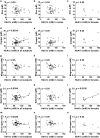Total plasma magnesium, zinc, copper and selenium concentrations in type-I and type-II diabetes
- PMID: 30671675
- PMCID: PMC7004817
- DOI: 10.1007/s10534-018-00167-z
Total plasma magnesium, zinc, copper and selenium concentrations in type-I and type-II diabetes
Abstract
Glycemia and insulin resistance are important regulators of multiple physiological processes and their dysregulation has wide-ranging consequences, including alterations in plasma concentrations of metal micronutrients. Here, magnesium, zinc, copper, selenium and glycated albumin (HbA1c) concentrations and quartile differences were examined in 45 subjects with type-I diabetes (T1DM), 54 subjects with type-II diabetes (T2DM) and 62 control subjects in order to assess potential differences between sexes and between T1DM and T2DM. Plasma magnesium concentration was decreased in T1DM subjects, with the second, third and fourth quartiles of magnesium concentrations associated with the absence of T1DM. This effect was observed in females but not males. In T2DM, the highest quartile of selenium concentrations and the third quartile of copper concentrations associated with the absence of diabetes in males. The highest quartile of magnesium concentrations was associated with the absence of T2DM in males but not females. HbA1c correlated with plasma concentrations of magnesium (negatively, in both sexes together in T1DM and T1DM males), copper (positively, in T1DM males and in both sexes together in T2DM), selenium (positively, in both sexes together in T1DM and T2DM, and T2DM females) and with zinc/copper ratio (negatively, in both sexes together in T1DM and T2DM). This study shows that plasma magnesium concentration is altered to the highest degree in T1DM, while in T2DM, plasma selenium and copper concentrations are significantly affected. This work increases our understanding of how T1DM and T2DM affects plasma metal concentrations and may have future implications for diabetes management.
Keywords: Diabetes; HbA1c; ICP-MS; Metal homeostasis; Zinc/copper ratio.
Figures


Similar articles
-
Total plasma magnesium, zinc, copper and selenium concentrations in obese patients before and after bariatric surgery.Biometals. 2023 Apr;36(2):241-253. doi: 10.1007/s10534-022-00368-7. Epub 2022 Feb 9. Biometals. 2023. PMID: 35138503 Free PMC article.
-
Comparative Study of Serum Copper, Iron, Magnesium, and Zinc in Type 2 Diabetes-Associated Proteinuria.Biol Trace Elem Res. 2015 Dec;168(2):321-9. doi: 10.1007/s12011-015-0379-3. Epub 2015 May 30. Biol Trace Elem Res. 2015. PMID: 26024734
-
Trace elements in type 2 diabetes mellitus and their association with glycemic control.Afr Health Sci. 2020 Mar;20(1):287-293. doi: 10.4314/ahs.v20i1.34. Afr Health Sci. 2020. PMID: 33402917 Free PMC article.
-
Trace elements, magnesium, and the efficacy of antioxidant systems in children with type 1 diabetes mellitus and in their siblings.Adv Clin Exp Med. 2014 Mar-Apr;23(2):259-68. doi: 10.17219/acem/37074. Adv Clin Exp Med. 2014. PMID: 24913117
-
Coagulatory Defects in Type-1 and Type-2 Diabetes.Int J Mol Sci. 2019 Dec 16;20(24):6345. doi: 10.3390/ijms20246345. Int J Mol Sci. 2019. PMID: 31888259 Free PMC article. Review.
Cited by
-
Total plasma magnesium, zinc, copper and selenium concentrations in obese patients before and after bariatric surgery.Biometals. 2023 Apr;36(2):241-253. doi: 10.1007/s10534-022-00368-7. Epub 2022 Feb 9. Biometals. 2023. PMID: 35138503 Free PMC article.
-
The Association Between Plasma Copper Concentration and Prevalence of Diabetes in Chinese Adults With Hypertension.Front Public Health. 2022 Jun 3;10:888219. doi: 10.3389/fpubh.2022.888219. eCollection 2022. Front Public Health. 2022. PMID: 35747779 Free PMC article.
-
An observational study to estimate the level of essential trace elements and its implications in type 2 diabetes mellitus patients.J Family Med Prim Care. 2021 Jul;10(7):2594-2599. doi: 10.4103/jfmpc.jfmpc_2395_20. Epub 2021 Jul 30. J Family Med Prim Care. 2021. PMID: 34568141 Free PMC article.
-
The Association between Zinc and Copper Circulating Levels and Cardiometabolic Risk Factors in Adults: A Study of Qatar Biobank Data.Nutrients. 2021 Aug 9;13(8):2729. doi: 10.3390/nu13082729. Nutrients. 2021. PMID: 34444889 Free PMC article.
-
Reduced Plasma Magnesium Levels in Type-1 Diabetes Associate with Prothrombotic Changes in Fibrin Clotting and Fibrinolysis.Thromb Haemost. 2020 Feb;120(2):243-252. doi: 10.1055/s-0039-3402808. Epub 2020 Jan 3. Thromb Haemost. 2020. PMID: 31942750 Free PMC article.
References
-
- Akbaraly TN, Arnaud J, Rayman MP, Hininger-Favier I, Roussel AM, Berr C, Fontbonne A. Plasma selenium and risk of dysglycemia in an elderly French population: results from the prospective Epidemiology of Vascular Ageing Study. Nutr Metab (Lond) 2010;7:21. doi: 10.1186/1743-7075-7-21. - DOI - PMC - PubMed
-
- Atari-Hajipirloo S, Valizadeh N, Khadem-Ansari MH, Rasmi Y, Kheradmand F. Altered concentrations of copper, zinc, and iron are associated with increased levels of glycated hemoglobin in patients with type 2 diabetes mellitus and their first-degree relatives. Int J Endocrinol Metab. 2016;14(2):e33273. doi: 10.5812/ijem.33273. - DOI - PMC - PubMed
Publication types
MeSH terms
Substances
Grants and funding
LinkOut - more resources
Full Text Sources
Medical

